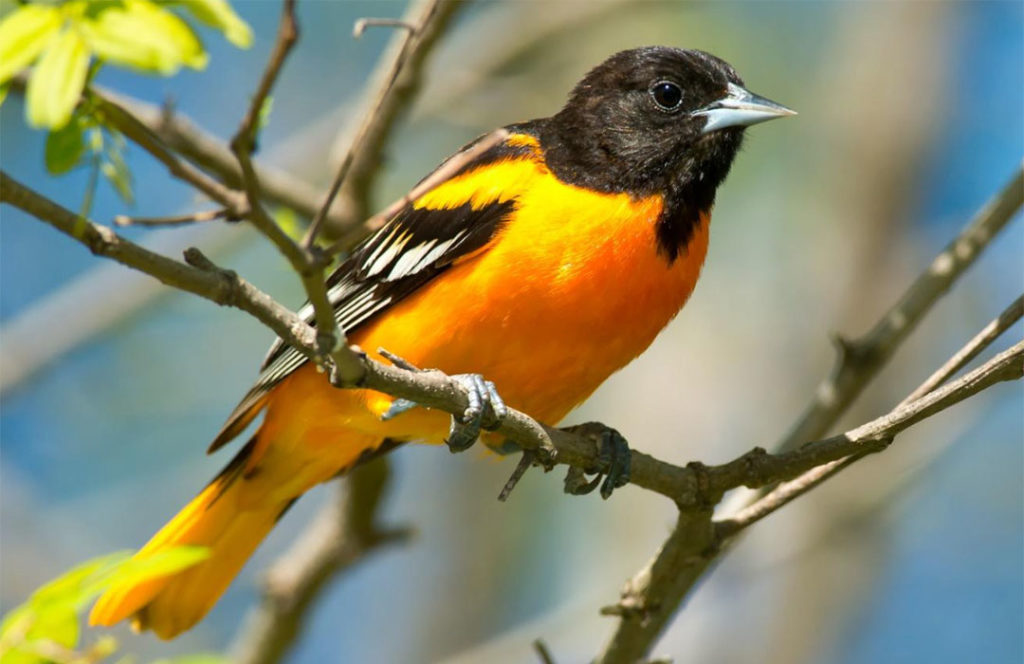Get To Know This Year’s Featured Migratory Bird Day Species: Baltimore Oriole

VITAL SIGNS
- Common name: Baltimore Oriole
- Latin name: Icterus galbula
- Range: Found in Southern areas of Easternmost Canadian provinces3.
- Lifespan: 11 years3
- Size: Ranging in length from 17-19 cm, and a wingspan of 23-30 cm3.
- Population estimate: 12 million (globally)
THE FACTS
The Baltimore Oriole, not to be confused with the baseball team; are small, brightly coloured migratory birds. Males have bright orange and black bodies with white striped wings, whereas females are duller yellow and grey3. Their diet changes depending on the season. From May to late Summer, their diet mainly consists of insects as they are high in necessary protein. They will consume insects such as beetles, crickets, grasshoppers, moths, and snails3. Baltimore Orioles may also feed on invasive pest species, such as the gypsy moth, a highly invasive species to North America.
In spring and fall, high-in-sugar nectar and fruits provide ample energy for migration. The Baltimore Oriole is widely known to feed on fruit crops, including raspberries, mulberries, cherries and oranges3.
When nesting, Baltimore Orioles tend to nest in American Elms but may nest in maple or cottonwood trees as well3. They typically have a clutch size of 3-7 eggs with nestlings typically leaving the nest 12-14 days after hatching.
THE STORY
Though the species has shown to be relatively tolerant of human interference, there are still many threats to their populations. Increasing urbanization and development cause an increase in habitat loss through the destruction of green spaces and both an increase and changes to agriculture in general, specifically chemicals and pesticides used.2 Threats to this species can come in the form of heatwaves, and an increased range of wildfires1.
WHAT IS BEING DONE
The species was classified as “Least Concern” by IUCN Global in 20184 and was designated as Secure by Wild Species Canada in 20102. It is also considered a Priority Species in the Bird Conservation Region Strategy in the Prairie and Northern regions, as well as Ontario and Quebec2.
WHAT YOU CAN DO
Like many species, an increasing global climate is bound to affect the population numbers and habitats of the Baltimore Oriole. Avoid spraying pesticides on trees that the species frequents, as this can harm important food sources and may poison the birds directly. Refrain from using pesticides in your gardens or lawn and opt for more bird-friendly options instead
Get involved with a local Bird Team in your community to work towards becoming Bird Friendly City Certified. Or host and participate in an upcoming World Migratory Bird Day event near you!
2Status of Migratory Birds in Canada: Baltimore Oriole. 2014. Government of Canada https://wildlife-species.canada.ca/bird-status/oiseau-bird-eng.aspx?sY=2014&sL=e&sM=c&sB=BAOR
3The Cornell Lab, 2019. All About Birds: Baltimore Oriole https://www.allaboutbirds.org/guide/Baltimore_Oriole
4Icterus galbula (Baltimore Oriole). IUCN Red List of Threatened Species. 2022. IUCN Global https://www.iucnredlist.org/species/22724126/132026652&sa=D&source=docs&ust=1651519778676981&usg=AOvVaw27aQm5rYIHaGilbwjHAjJ2



